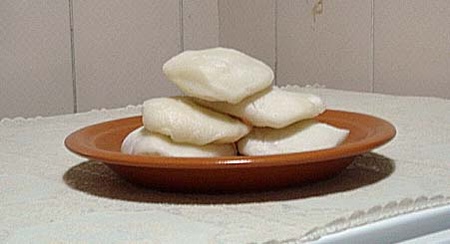“On Christmas Day, we’ll have Brazilian dishes, and on Oshogatsu1 we’ll have the Japanese New Year’s traditional foods. We Nikkei can enjoy twice as many banquets. We’re truly blessed!”
That’s what Mom used to say at the end of every year.
And I think the same way. It’s an advantage to belong to two different cultures.
At our family’s Christmas and New Year’s celebrations, there were always the three of us: Dad, Mom, and me. Although our numbers were small, our gatherings were a very important time in our lives. I felt it deeply on the first day of 1991. Mom had died in May of the previous year, and I had made and served the ozoni the way she used to.
When he saw the table all set up, Dad started sobbing. I was so taken aback that I just stood still, not knowing what to do. His tears were an expression of his gratitude and feelings for his wife, who had remained at his side for 48 years. Afterwards, he actually apologized, saying: “I’m sorry. I didn’t mean to cry.”
Mom’s ozoni was something special to me since childhood. At first sight, it looked more flavorful than a soup dish, besides the fact that the round mochi inside the bowl was an unusual ingredient. Back then, this glutinous rice cake was served only on special occasions. I remember that Mom used to order them in advance and, on December 31, Dad would pick them up at the store.
For a long time, the only ozoni I was familiar with was Mom’s ozoni. But one time, as I was talking with a co-worker about traditional New Year’s dishes, ozoni came up. That’s when she told me something unusual: “Did you know that, besides carrots and yams, if you were to add gobo, that would make it even tastier?”
“Huh?! What are you talking about? Isn’t that nishime?
When I got home, I told Mom about it right away; she seemed to be enjoying herself while looking at my flabbergasted and confused face. She explained: “The way to prepare ozoni depends on the region in Japan the family comes from, because over there the ozoni varies according to the shape of the mochi, the types of ingredients, and the preparation methods of each place.”
Even so, Mom’s ozoni remained unbeatable, and today I miss it a lot.
Here’s another story about mochi.
Until I was 12, I thought that mochi was round and hard on the outside. But that summer, I visited the house of my maternal grandparents and for the first time I ate freshly made mochi—which is different from the one bought at the store, for it’s soft and you could stretch it like rubber. It was a surprise!
Another surprise was watching my grandmother—shorter than me and very thin—getting her hands wet and quickly kneading the special, steam-cooked rice dough, following the beat of the kine2. And my uncle displayed such strength, as he pounded that dough inside the mortar and lifted the heavy kine.
I ate mochi seasoned with diced green onions and shoyu served with natto, my grandmother’s homemade recipe. After that, natto also became my favorite dish.
And I’ve never forgotten the flavor of freshly made mochi!
Now, I’m going to tell a story about the kagami mochi, an offering made with double-layered mochi that is placed in Buddhist butsudan. I had already seen that in movies, in magazines, and in Japanese manga—but never here in Brazil. So, one day I went to visit a Nikkei family and, right in the garage, I saw some white things on top of their car. In the living room, several white things adorned the table next to the television set. And upon walking into the kitchen, there was a similar adornment atop the fridge.
Could that be the kagami mochi? It was certainly quite different from what I was familiar with. Since their lower side wasn’t flat, instead of lying one on top of the other, these mochi formed a pyramid. Since I had never seen anything like the Japanese original in stores selling Japanese goods, I assumed that this was the Brazilian version of kagami mochi. Quite another surprise, all the same!
I went to Japan for the first time 40 years ago, when I was able to experience the legitimate Oshogatsu. That’s when I learned that there was a small and square mochi—the lady at the boarding house had grilled one and served it to us. I also went to see the mochitsuki, a mochi-making ceremony that was just like what I had seen at my grandmother’s house more than 10 years earlier. That brought back memories of my grandmother’s mochi.
More recently, four years ago, I watched a mochitsuki ceremony in Japan. This time, my mind wasn’t just focused on the flavor of mochi, for I marveled at the hunks dressed in happi³ and wearing headbands, as they prepared the rice dough inside the mortar.
After that, I enjoyed the freshly made mochi with some sweet bean paste. Delicious!
Today, I’m also going to celebrate with ozoni the arrival of the New Year.
Happy New Year to everyone!
Notes:
1. New Year
2. Wooden pestle used to pound the mochi in the mortar
3. Short kimono
© 2014 Laura Honda-Hasegawa





